Automated Charting of the Visual Space of Housefly Compound Eyes
Instructor Prep
concepts
Student Protocol
The protocol is in accordance with the University's insect care guidelines.
1. Preparation of a housefly, Musca domestica
- Collect the fly from the laboratory-reared population. Place the fly in the brass holder (Figure 1).
- Cut 6 mm from the upper part of the restraining tube (see Table of Materials). The new upper part of the tube has an external diameter of 4 mm and an internal diameter of 2.5 mm (Figure 1A). Place the live fly inside the tube, seal the tube with cotton to prevent damaging the fly, and push the fly such that the head protrudes from the tube and its body is restrained (Figure 1B). Immobilize the head with beeswax such that the eyes remain uncovered (Figure 1C-E).
- Cut the tube again such that the tube length is 10 mm (Figure 1C). Place the plastic tube with the fly in the brass holder, such that one eye of the fly is pointing upward when the holder is resting on a tabletop (Figure 1D,E).
- Adjust the orientation of the tube such that with the goniometer elevation at 0° (i.e., the azimuth stage is in a horizontal position), the vertical illumination beam of the microscope is perpendicular to the eye surface in a central region, between ventral and dorsal, and between anterior and posterior edges of the eye, so that the whole eye can be scanned within the range of azimuth and elevation allowed by the setup.
2. Alignment of the goniometer's rotating azimuth axis with the microscope optical axis
- Mount an alignment pin on the azimuth rotation stage so that the x-y position of the tip can be adjusted to coincide with the azimuth axis on the motorized stage. While viewing with the microscope, equipped with a 5x objective, focus on the tip using the z-axis joystick (Figure 2).
- Align the x-y adjustment of the azimuth axis with the microscope's optical axis and ensure that the elevation and azimuth rotary axes are pre-aligned with the centered pin, using the x- and y-axis joysticks.
- Manipulate the azimuth and elevation joysticks to check whether the pin is centered with respect to both degrees of freedom. When well-centered, the pin tip remains in, approximately, the same position during azimuth and elevation rotations.
3. Alignment of the fly eye with the motorized stages
- With the elevation stage at 0°, mount the fly and its holder on the azimuth stage. Observe the fly's eye with the microscope.
- With the illumination LED on, adjust the horizontal position of the fly so that the center of the pseudopupil is aligned with the microscope. Adjust the vertical position of the fly by using the rotating screw of the holder (Figure 1D), so that the deep pseudopupil (DPP; Figure 3)19,20,21 is brought into focus at the level of the elevation axis.
- Align the DPP with respect to the azimuth and elevation axes by centering it in the field of view (see Figure 2). Use the magnets glued to the bottom of the fly holder to affix it firmly to an iron plate mounted on the azimuth stage, while permitting manual sliding adjustments.
- Switch the view to the digital camera mounted at the microscope. Run the software initialization of the GRACE system, which includes initializing the motor controllers and the Arduino LED controller (Figure 4). Therefore, open MATLAB R2020a or higher version. Run the MATLAB script Initialize_All_Systems (Supplementary File 1).
- Confirm whether the fly's pseudopupil (Figure 3B,C) is at the center of the projected image on the computer screen.
4. Autofocusing and autocentering
- Bring the focus to the level of the corneal pseudopupil (CPP; Figure 3B)19,20,21 manually by using the z-axis joystick.
- Run the autofocusing algorithm (Supplementary File 1, script AF) to attain a sharp image at the cornea level. Check by returning the focus to the DPP level by adjusting the motorized z-axis stage. Store the distance between the DPP and CPP (in motor steps).
- Fine-tune the pseudopupil centering by running the autocentering algorithm (Supplementary File 1, script AC). Bring the focus back to the CPP level.
- Re-run the autofocusing algorithm. Zero the motorized stages at their current positions (X,Y,Z,E,A) = (0,0,0,0,0), where E is elevation and A is azimuth.
- Run the scanning algorithm (Supplementary File 1, script Scan_Begin), which samples eye images along trajectories in 5° steps, while performing the autocentering and autofocusing algorithms.
- At the conclusion of the sampling, turn off the LED Controller, and the motor controllers.
- Process the images by applying the image processing algorithms (Supplementary File 1, script ImProcFacets).
Automated Charting of the Visual Space of Housefly Compound Eyes
Learning Objectives
Animals and optical stimulation
Experiments are performed on houseflies (Musca domestica) obtained from a culture maintained by the Department of Evolutionary Genetics at the University of Groningen. Before the measurements, a fly is immobilized by gluing it with a low-melting-point wax in a well-fitting tube. The fly is subsequently mounted on the stage of a motorized goniometer. The center of the two rotary stages coincides with the focal point of a microscopic setup24. The epi-illumination light beam is supplied by a light source, which focuses light on a diaphragm that is imaged at the fly's eye via a half-mirror. It, thus, activates the pupil mechanism of a restricted set of photoreceptor cells (Figure 3). The optical axes of the ommatidia that harbor these photoreceptors are assessed by rotating the fly in small steps and taking photographs after each step with a color digital camera attached to a microscope (Figure 2). Because the pupillary pigment granules reflect predominantly in the long-wavelength range, the red channel of the digital camera is used to discriminate the pseudopupil from the facet lens reflections. The latter reflections are best isolated from the pseudopupil using the camera's blue channel.
Autofocusing and autocentering algorithms
The main additional algorithms used while scanning an insect's eye are the autofocusing and autocentering (Supplementary File 1, scripts AF and AC). The goal of autofocusing is to bring the corneal level to the focus of the camera, in order to detect the facet reflections that are necessary for the identification of individual ommatidia (Figure 3B). The procedure for detecting the corneal level is to change the vertical (Z) position of the fly in steps by applying the fast Fourier transform (FFT) to the image taken at each level to determine the spatial frequency content. The criterion for optimal focus is the level with the greatest summed power above a low-frequency cutoff.
The inputs for autofocusing are the Z-positions and streaming video from the camera. The outputs are the integral of the high-frequency content of the image SF and the focusing level Z where SF is maximal. In the initial step, the Z-position of the camera image is adjusted to slightly below the corneal facet lenses, and the region of interest to determine the image's frequency content is set. The for loop starts the image capture and calculates the sum of the high-pass filtered Fourier-transform SF. By then stepping the z-axis motor upward to an image level above the cornea, the level with the highest frequencies is found, i.e., where SF is maximal, which is taken to be the corneal level. The z-axis motor is then adjusted to that level and an image is taken.
When focusing down from the cornea toward the level of the eye's center of curvature, the corneal facet reflections fade away, and the pseudopupil reflections coalesce into a typical seven-dot pattern, which is a characteristic for the organization of the photoreceptors within the fly ommatidia (Figure 3C; note that the pattern is only distinct in approximately spherical eye areas). The pattern at the eye's center of curvature level is called the deep pseudopupil (DPP)19,21.
Shifting the fly positioned at the stage with the X- and Y-motors so that the center of the light spot coincides with the center of the camera image is called autocentering. This procedure aligns the facet of the ommatidium whose visual axis is in the center of the DPP with the illumination beam and the optical axis of the microscope and camera. The image is Gaussian filtered and binarized, and then the center of the pseudopupil is determined using the regionprops MATLAB function. The inputs are the positions of the X- and Y-motors and the streaming video from the camera; the output is the distance between the centers of image and pseudopupil, which is then translated into a stage shift.
Correlating images
The eye is scanned by taking and storing photographs at various values of the goniometer elevation θ and azimuth φ after the autofocusing and autocentering procedures. Two-dimensional correlation is used to determine the x-y shifts between successive images. To correlate the images obtained at different angular positions, it is essential to realize that this generally results in a rotation of the current image with respect to the previous image. For instance, let us assume that the center of an initial image corresponds to point C of a sphere (Figure 5) and that a change in azimuth occurs so that plane OAB is rotated over a small angle Δφ, becoming plane OA'B. The center of the image then changes from point C to point C' (Figure 5). If the camera image plane is perpendicular to the vector OC, rotation of plane OAB to OA'B causes rotation of the image over an angle β = Δφ cosθ, as β = CC'⁄BC, with CC' = CDΔφ, and cosθ = CD⁄BC (Figure 5). This means that at the top of the sphere (θ = 0°), β = Δφ, and at the equator (θ = 90°), β = 0°. When Δφ = 0°, that is, when only the elevation θ is changed, the images are not rotated with respect to each other, so β = 0°.
During the scanning procedure, the autocentering procedure centers the ommatidium whose visual axis is aligned with the optical axis of the measuring system. Rotation of the azimuth causes a rotation by an angle β and a translation of the facet pattern. To determine the latter shift, two successive images are correlated (after first rotating the first image by the rotation angle β), as explained in Figure 6.
In the image shift algorithm (Supplementary File 1, script ImProcFacets), the individual facets are identified by the centroids of their reflections in each image. The inputs to the algorithm are the elevation and azimuth angle, the set of images to be assessed, the image channel, and the region of interest. The algorithm produces a set of centroids and a final image that contains all of the correlated images taken during the scanning procedure.
The goniometric system
In order to achieve alignment with the illumination, the fly's eye has to be photographed with the corneal facet lenses in focus, and the pseudopupil must be recentered frequently (here, after every 5° of rotation). This automatic process is realized with the GRACE system (Goniometric Research Apparatus for Compound Eyes), shown schematically in Figure 4. It consists of three main subsystems: the lower and upper stages with their respective electronics as the electromechanical hardware, the firmware embedded in the physical controllers, and the PC used to operate the software that implements the algorithms. The hardware consists of the motorized and optical stages, the digital camera, a microcontroller for programming LED intensities, and a white LED light source. The firmware's routines are provided with the motor controllers, the LED Controller, and in the digital camera. The software consists of the algorithms for controlling motor positions and speeds, adjusting the LED, and acquiring and analyzing images. The algorithms discussed next represent the major milestones that enable the GRACE system to scan insect eyes.
Fly eyes and pseudopupils
When a housefly eye is illuminated, the incident light activates the pupil mechanism of the photoreceptor cells, a system of mobile, yellow-colored pigment granules inside the cell body. The system controls the light flux that triggers the phototransduction process of the photoreceptors, and thus has essentially the same function as the pupil in the human eye19,20. The activation of the pupil mechanism causes a locally enhanced reflection in the eye area facing the aperture of the microscope's objective (Figure 3). The position of the brightly reflecting eye area, the pseudopupil19,20,21, changes upon rotation of the eye because the incident light then activates the pupil mechanism in a different set of photoreceptor cells (see Figure 6). The pseudopupil thus acts as a marker of the visual axis of the ommatidia that are aligned with the microscope. This allows mapping of the spatial distribution of the eye's visual axes 4,20,21,22,23.
Filling in missing facets
Not all facets are identified by the centroid procedure, for instance, due to a low local reflectance caused by minor surface irregularities or specks of dust. The latter can also result in erroneous centroids (Figure 7A). This problem is resolved first by washing the eyes under a water tap and secondly by applying a filling-in procedure (script ImProcFacets). Therefore, the centroids in an area are first determined (Figure 7A), and then the FFT is calculated (Figure 7B). The first ring of harmonics (yellow stars in Figure 7B) defines three orientations, indicated by the blue, red, and green lines (Figure 7B). Inverse transformation of the harmonics along the three orientations yields the gray bands in Figure 7C–E. Fitting a second-order polynomial to the gray bands yields lines connecting the facet centroids along the three lattice axes. The crossing points of the lattice lines, thus, correspond to the true facet centers. As the example of Figure 7 is an extreme case, it demonstrates that the procedure is robust. In most areas, missing facets and erroneous centroids are rare.
Scanning a fly eye
Figure 8 shows a band of ommatidia scanned across the eye by performing a series of stepwise azimuthal changes with Δφ = 5°. Scanning from the frontal side of the eye (Figure 8A, right) to the lateral side (Figure 8A, left) occurred in 24 steps. The centroids of the largely overlapping facet patterns were subsequently rotated by β = Δφcosθ. Then, after shifting the centroids of each image and filling in the missing facets (with script ImProcFacets), the colocalized centroids were averaged. Figure 8A shows the combined images, together with the image centers and facet centroids. Figure 8B shows the assembly of facets as a Voronoi diagram.
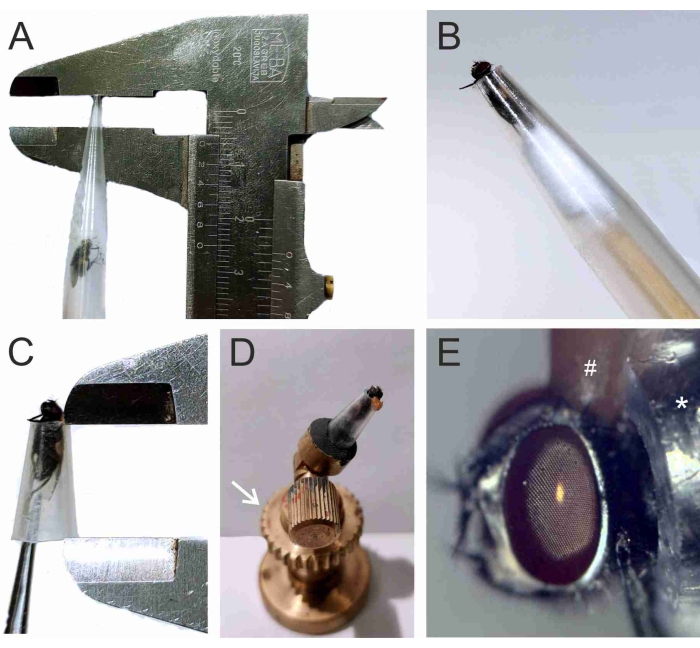
Figure 1: Mounting the fly into the brass holder. (A) A tip with a housefly to be investigated. (B) The cut tip with the fly gently pushed to the end using a piece of cotton and a chopstick. (C) The tip with the fly further cut to a total length of 10 mm. (D) The brass holder with the fly to be placed on the goniometer stage; the arrow points to the height adjustment screw. (E) Close-up photo of the fly with the head immobilized by a piece of low-temperature melting wax (#) to the tip (*). Epi-illumination has activated the pupil mechanism of the eye's photoreceptors, as revealed by the yellow pseudopupil. Please click here to view a larger version of this figure.
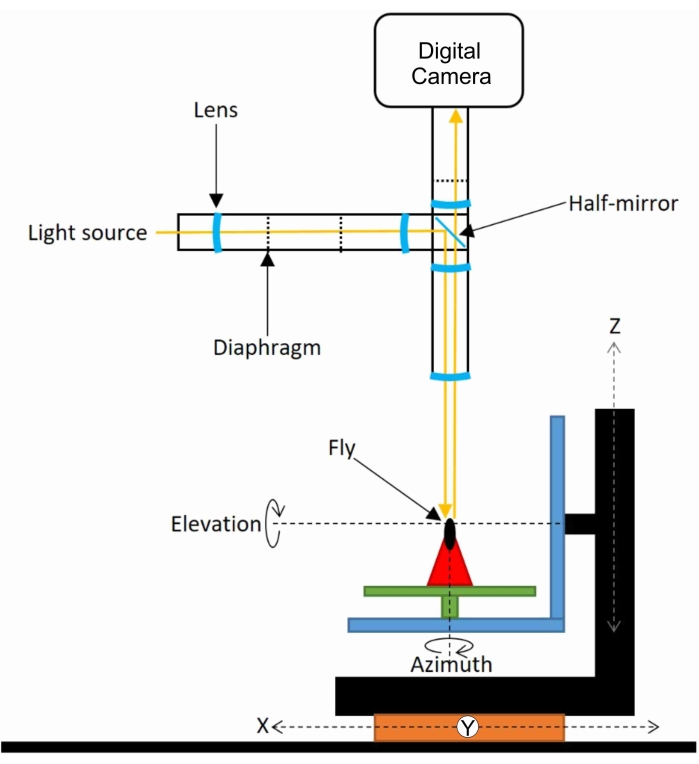
Figure 2: GRACE, the Goniometric Research Apparatus for Compound Eyes. The investigated insect (a fly) is mounted at the motorized stage consisting of three translation stages (X, Y, Z) and two rotation stages (elevation and azimuth). A lens focuses light from a white LED at a diaphragm, focused via a half-mirror at the fly's eye. The eye is photographed with a camera attached to a microscope. Please click here to view a larger version of this figure.

Figure 3: Optics of fly eyes. (A) Diagram of three ommatidia of a fly eye, each capped by a biconvex facet lens, which focuses incident light onto a set of photoreceptor cells (yellow), surrounded by primary (brown) and secondary (red) pigment cells. Intense illumination of dark-adapted (DA) photoreceptors causes migration of yellow pigment granules (indicated by black dots), which exist inside the photoreceptor cells. Accumulated toward the tip of the photoreceptors, near the light-sensitive organelles, the rhabdomeres, they absorb and backscatter light in the light-adapted (LA) state. (B) Image at the level of the eye surface, showing the facet reflections (bright dots) as well as the pigment granule reflection in the activated state (the corneal pseudopupil, CPP). (C) Image taken at the level of the center of eye curvature (the deep pseudopupil, DPP), reflecting the arrangement of the photoreceptor cells in a trapezoidal pattern, with their distal ends positioned at about the focal plane of the facet lenses. A superimposed virtual image of the photoreceptor tips, thus, exists in the plane of the center of eye curvature. Scale bar 100 µm applies to panels B and C. Please click here to view a larger version of this figure.

Figure 4: Schematic diagram of the GRACE system. The PC software controls the firmware, which drives the electromechanical hardware. The digital camera takes, via an optical stage, images of the specimen's eye. The LED light source illuminates the specimen, and the motors of the motorized stage actuate the X-, Y-, and Z-translations as well as the azimuth (A) and elevation (E) rotations. Please click here to view a larger version of this figure.
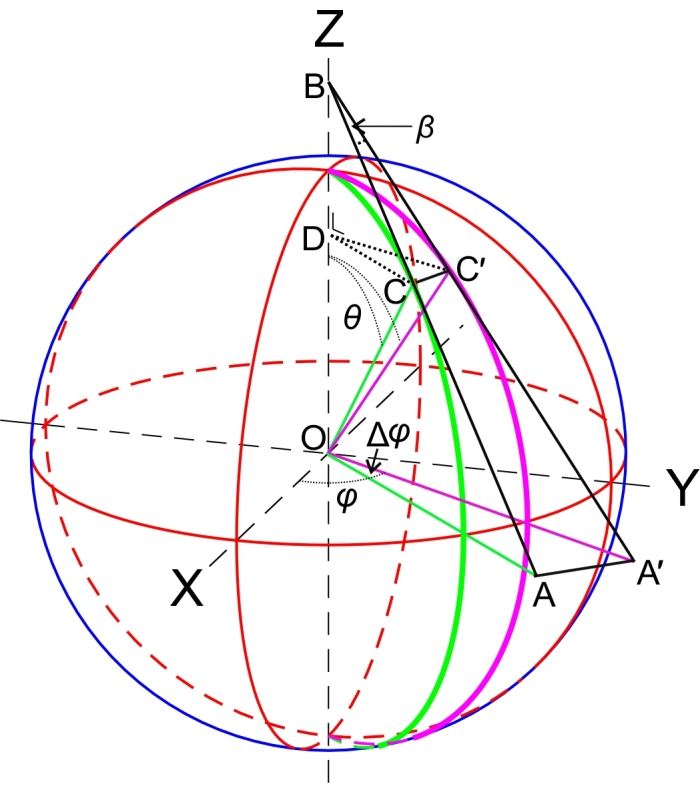
Figure 5: Diagram for deriving the image rotation when scanning the fly eye. If the center of an initial image corresponds to point C of a sphere and a change in azimuth occurs, plane OAB is rotated over a small angle Δφ, becoming plane OA'B. The center of the image then changes from point C to point C'. Rotation of plane OAB to OA'B causes rotation of the image over an angle β = Δφ cosθ (see text, section Correlating images). Please click here to view a larger version of this figure.
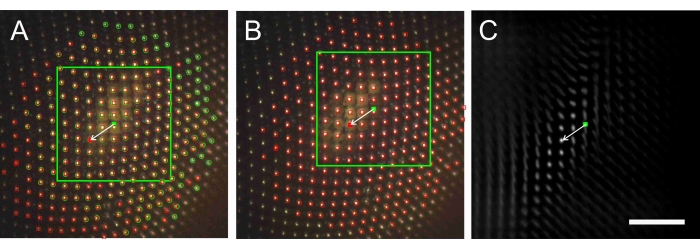
Figure 6: The image processing procedure for determining the interommatidial angle. (A) Image taken during a scan across the eye, with facet centroids marked by green circles and red squares, and a green dot at the image center. (B) Subsequent image after an azimuthal rotation of 5°, with facet centroids marked by red squares and a red dot at the image center. (C) Correlogram of the area within the green square of A correlated with image B. The vector from the center of C (green dot) to the maximum value of the correlogram represents the relative shift of images A and B. Using that vector, the shifted square of A and its center are drawn in B and the facet centroids (red squares) of B are added in A. Scale bar 100 μm applies to panels A-C. Please click here to view a larger version of this figure.
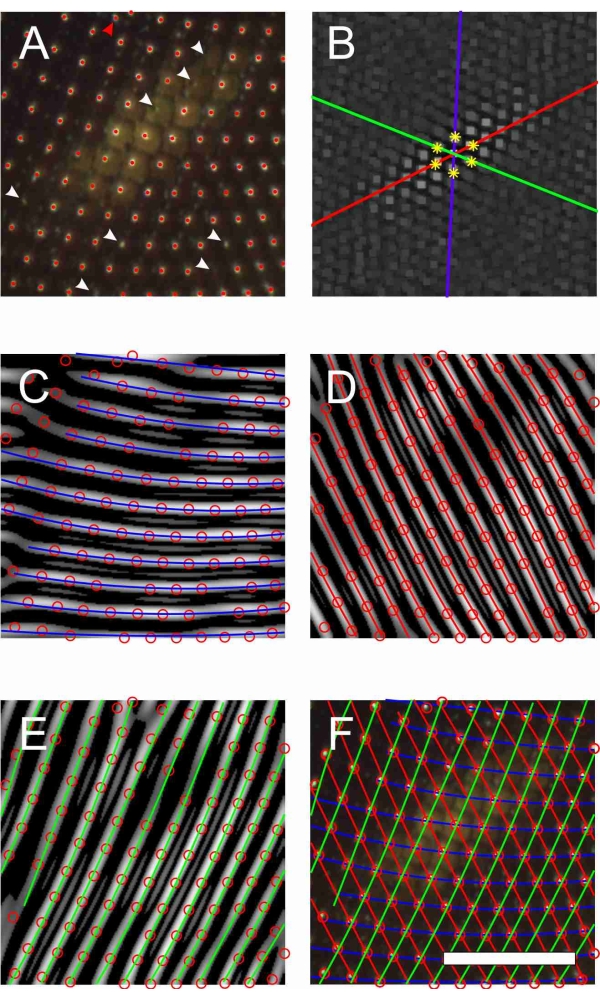
Figure 7: Deriving missing facet centroids by applying Fourier transforms. (A) A local RGB image with facet centroids (red dots). White arrowheads indicate missing facets, and the red arrowhead points to an erroneous centroid. (B) FFT of the centroids of A with the first ring of harmonics marked by yellow stars. (C–E) Inverse FFT of the centroids along the three directions indicated by the colored lines in B, yielding the grayish bands. The blue (C), red (D) and green (E) lines are quadratic polynomial fits to the gray bands, and the centroids (red circles) are those which were obtained prior to the Fourier transforms. (F) The fitted lines of C-E combined, together with the centroids of A. The missing facet centroids are then derived from the crossing points. Scale bar 100 μm applies to panels A, C-F. Please click here to view a larger version of this figure.
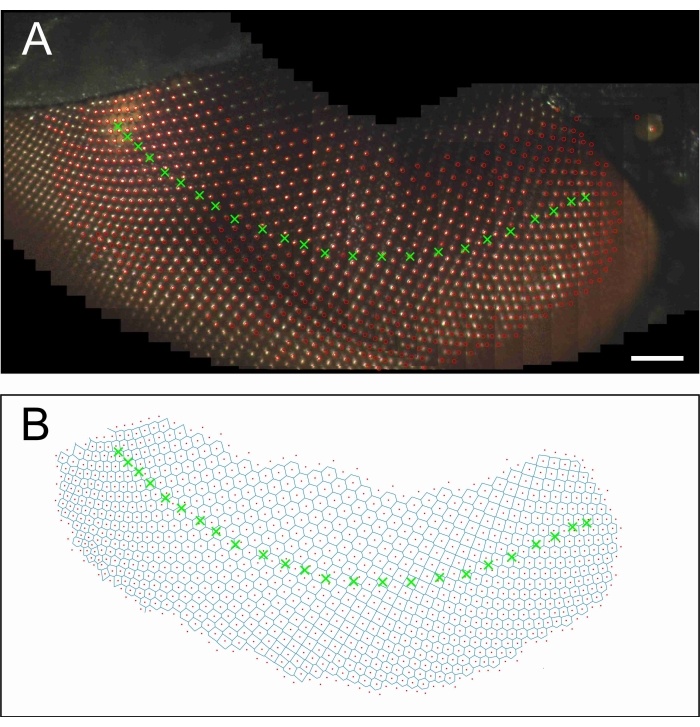
Figure 8: The right eye of a housefly scanned from one side to the other side. (A) Combined, overlapping images of an image series in which the azimuth was changed stepwise by 5°, together with the image centers (green crosses) and the facet centroids (red circles). (B) Voronoi diagram of the facet centroids, with the image centers as in A. Scale bar 100 μm applies to panels A and B. Please click here to view a larger version of this figure.
Supplementary File 1: Please click here to download this File.
List of Materials
| Digital Camera | PointGrey | BFLY-U3-23S6C-C | Acquision of amplified images and digital communication with PC |
| High power star LED | Velleman | LH3WW | Light source for observation and imaging the compound eye |
| Holder for the investigated fly | University of Groningen | Different designs were manufactured by the university workshop | |
| Linear motor | ELERO | ELERO Junior 1, version C | Actuates the upper microscope up and down. (Load 300N, Stroke speed 15mm/s, nominal current 1.2A) |
| Low temperature melting wax | various | The low-temperature melting point wax serves to immobilize the fly and fix it to the holder | |
| Microscope | Zeiss | Any alternative microscope brand will do; the preferred objective is a 5x | |
| Motor and LED Controller | University of Groningen | Z-o1 | Designed and built by the University of Groningen and based on Arduino and Adafruit technologies. |
| Motorized Stage | Standa (Vilnius, Lithuania) | 8MT175-50XYZ-8MR191-28 | A 6 axis motorized stage modified to have 5 degrees of freedom. |
| Optical components | LINUS | Several diagrams and lenses forming an epi-illumination system (see Stavenga, Journal of Experimental Biology 205, 1077-1085, 2002) | |
| PC running MATLAB | University of Groningen | The PC is able to process the images of the PointGrey camera, control the LED intensity, and send control commants to the motor cotrollers of the system | |
| Power Supply (36V, 3.34A) | Standa (Vilnius, Lithuania) | PUP120-17 | Dedicated power supply for the STANDA motor controllers |
| Soldering iron | various | Used for melting the wax | |
| Stepper and DC Motor Controller | Standa (Vilnius, Lithuania) | 8SMC4-USB-B9-B9 | Dedicated controllers for the STANDA motorized stage capable of communicating with MATLAB |
| Finntip-61 | Finnpipette Ky, Helsinki | FINNTIP-61, 200-1000μL | PIPETTE TIPS FOR FINNPIPETTES, 400/BOX. It is used to restrain the fly |
| Carving Pen Shaping/Thread Burning Tool | Max Wax | The tip of the carving pen is designed to transfer wax to the head of fly | |
| MATLAB | Mathworks, Natick, MA, USA | main program plus Image Acquisition, Image Analysis, and Instrument Control toolboxes. | Programming language used to implement the algorithms |
Lab Prep
This paper describes the automatic measurement of the spatial organization of the visual axes of insect compound eyes, which consist of several thousands of visual units called ommatidia. Each ommatidium samples the optical information from a small solid angle, with an approximate Gaussian-distributed sensitivity (half-width on the order of 1˚) centered around a visual axis. Together, the ommatidia gather the visual information from a nearly panoramic field of view. The spatial distribution of the visual axes thus determines the eye’s spatial resolution. Knowledge of the optical organization of a compound eye and its visual acuity is crucial for quantitative studies of neural processing of the visual information. Here we present an automated procedure for mapping a compound eye’s visual axes, using an intrinsic, in vivo optical phenomenon, the pseudopupil, and the pupil mechanism of the photoreceptor cells. We outline the optomechanical setup for scanning insect eyes and use experimental results obtained from a housefly, Musca domestica, to illustrate the steps in the measurement procedure.
This paper describes the automatic measurement of the spatial organization of the visual axes of insect compound eyes, which consist of several thousands of visual units called ommatidia. Each ommatidium samples the optical information from a small solid angle, with an approximate Gaussian-distributed sensitivity (half-width on the order of 1˚) centered around a visual axis. Together, the ommatidia gather the visual information from a nearly panoramic field of view. The spatial distribution of the visual axes thus determines the eye’s spatial resolution. Knowledge of the optical organization of a compound eye and its visual acuity is crucial for quantitative studies of neural processing of the visual information. Here we present an automated procedure for mapping a compound eye’s visual axes, using an intrinsic, in vivo optical phenomenon, the pseudopupil, and the pupil mechanism of the photoreceptor cells. We outline the optomechanical setup for scanning insect eyes and use experimental results obtained from a housefly, Musca domestica, to illustrate the steps in the measurement procedure.
Procedure
This paper describes the automatic measurement of the spatial organization of the visual axes of insect compound eyes, which consist of several thousands of visual units called ommatidia. Each ommatidium samples the optical information from a small solid angle, with an approximate Gaussian-distributed sensitivity (half-width on the order of 1˚) centered around a visual axis. Together, the ommatidia gather the visual information from a nearly panoramic field of view. The spatial distribution of the visual axes thus determines the eye’s spatial resolution. Knowledge of the optical organization of a compound eye and its visual acuity is crucial for quantitative studies of neural processing of the visual information. Here we present an automated procedure for mapping a compound eye’s visual axes, using an intrinsic, in vivo optical phenomenon, the pseudopupil, and the pupil mechanism of the photoreceptor cells. We outline the optomechanical setup for scanning insect eyes and use experimental results obtained from a housefly, Musca domestica, to illustrate the steps in the measurement procedure.
